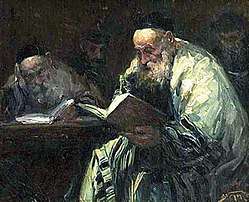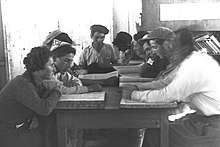Gemara
The Gemara (also transliterated Gemora, Gemarah, or, less commonly, Gemorra; from Hebrew גמרא, from the Aramaic verb gamar, study) is the component of the Talmud comprising rabbinical analysis of and commentary on the Mishnah. After the Mishnah was published by Judah the Prince (c. 200 CE), the work was studied exhaustively by generation after generation of rabbis in Babylonia and the Land of Israel. Their discussions were written down in a series of books that became the Gemara, which when combined with the Mishnah constituted the Talmud.
| Rabbinic literature | ||||||||||||
|---|---|---|---|---|---|---|---|---|---|---|---|---|
 Talmud Readers by Adolf Behrman | ||||||||||||
| Talmudic literature | ||||||||||||
|
||||||||||||
| Halakhic Midrash | ||||||||||||
|
||||||||||||
| Aggadic Midrash | ||||||||||||
|
||||||||||||
| Targum | ||||||||||||
|
||||||||||||

There are two versions of the Gemara. The Jerusalem Talmud (Talmud Yerushalmi) was compiled by scholars of the Land of Israel, primarily of the academies of Tiberias and Caesarea, and was published between about 350–400 CE. The Talmud Bavli (Babylonian Talmud) was published about 500 CE by scholars of Babylonia, primarily of the academies of Sura, Pumbedita, and Nehardea. By convention, a reference to the "Gemara" or "Talmud," without further qualification, refers to the Babylonian version. The main compilers were Ravina and Rav Ashi.
Gemara and Mishnah

The Gemara and the Mishnah together make up the Talmud. The Talmud thus comprises two components: the Mishnah – the core text; and the Gemara – analysis and commentary which "completes" the Talmud (see Structure of the Talmud).
The rabbis of the Mishnah are known as Tannaim (sing. Tanna תנא). The rabbis of the Gemara are referred to as Amoraim (sing. Amora אמורא).
Because there are two Gemaras, there are in fact two Talmuds: the Jerusalem Talmud (Hebrew: תלמוד ירושלמי, "Talmud Yerushalmi"), and the Babylonian Talmud (Hebrew: תלמוד בבלי, "Talmud Bavli"), corresponding to the Jerusalem Gemara and the Babylonian Gemara; both share the same Mishnah. The Gemara is mostly written in Aramaic, the Jerusalem Gemara in Western Aramaic and the Babylonian in Eastern Aramaic, but both contain portions in Hebrew. Sometimes the language changes in the middle of a story.
Origins of the word
In a narrow sense, the word Gemara refers to the mastery and transmission of existing tradition, as opposed to sevara, which means the deriving of new results by logic. Both activities are represented in the "Gemara" as a literary work. The term "gemara" for the activity of study is far older than its use as a description of any text: thus Pirke Avot (Ch.5), a work long preceding the recording of the Talmud, recommends starting "Mishnah" at the age of 10 and "Gemara" at the age of 15.
Homiletically, the word gemara (גמרא) spells out the first letters of the words Gabriel, Michael, Raphael and Uriel - the names of the angels that man is protected with when delving into Torah study.
The Sugya
The analysis of the Amoraim is generally focused on clarifying the positions, words and views of the Tannaim. These debates and exchanges form the "building-blocks" of the gemara; the name for such a passage of gemara is a sugya (סוגיא; plural sugyot). A sugya will typically comprise a detailed proof-based elaboration of the Mishna. Every aspect of the Mishnaic text is treated as a subject of close investigation. This analysis is aimed at an exhaustive understanding of the Mishna's full meaning.
In the Talmud, a sugya is presented as a series of responsive hypotheses and questions – with the Talmudic text as a record of each step in the process of reasoning and derivation. The Gemara thus takes the form of a dialectical exchange (by contrast, the Mishnah states concluded legal opinions – and often differences in opinion between the Tannaim. There is little dialogue). The disputants here are termed the makshan (questioner, "one who raises a difficulty") and tartzan (answerer, "one who puts straight").
The gemara records the semantic disagreements between Tannaim and Amoraim. Some of these debates were actually conducted by the Amoraim, though many of them are hypothetically reconstructed by the Talmud's redactors. (Often imputing a view to an earlier authority as to how he may have answered a question: "This is what Rabbi X could have argued ...") Rarely are debates formally closed.
Argumentation and debate

The distinctive character of the gemara derives largely from the intricate use of argumentation and debate, described above. In each sugya, either participant may cite scriptural, Mishnaic and Amoraic proof to build a logical support for their respective opinions. The process of deduction required to derive a conclusion from a prooftext is often logically complex and indirect. "Confronted with a statement on any subject, the Talmudic student will proceed to raise a series of questions before he satisfies himself of having understood its full meaning."[1] This analysis is often described as "mathematical" in approach; Adin Steinsaltz makes the analogy of the Amoraim as scientists investigating the Halakha, where the Tanakh, Mishnah, Tosefta and midrash are the phenomena studied.
Prooftexts
Prooftexts quoted to corroborate or disprove the respective opinions and theories will include:
- verses from the Tanakh: the exact language employed is regarded as significant;
- other mishnayot: cross-references to analogous cases, or to parallel reasoning by the Tanna in question;
- Beraitot (ברייתות) – uncodified mishnayot which are also sources of halakha (lit. outside material; sing. beraita ברייתא);
- references to opinions and cases in the Tosefta (תוספתא);
- references to the Halakhic Midrash (Mekhilta, Sifra and Sifre);
- cross-references to other sugyot: again to analogous cases or logic.
Questions addressed
The actual debate will usually centre on the following categories:
Language
Why does the Mishna use one word rather than another? If a statement is not clear enough, the Gemara seeks to clarify the Mishna's intention.
Logic
- See: List of Talmudic principles and Category:Talmud concepts and terminology
Exploring the logical principles underlying the Mishnah's statements, and showing how different understandings of the Mishnah's reasons could lead to differences in their practical application. What underlying principle is entailed in a statement of fact or in a specific instance brought as an illustration? If a statement appears obvious, the Gemara seeks the logical reason for its necessity. It seeks to answer under which circumstances a statement is true, and what qualifications are permissible. All statements are examined for internal consistency.
Legal
Resolving contradictions, perceived or actual, between different statements in the Mishnah, or between the Mishnah and other traditions; e.g., by stating that: two conflicting sources are dealing with differing circumstances; or that they represent the views of different Rabbis. Do certain authorities differ or not? If they do, why do they differ? If a principle is presented as a generalization, the gemara clarifies how much is included; if an exception, how much is excluded.
Biblical exposition
Demonstrating how the Mishnah's rulings or disputes derive from interpretations of Biblical texts. The Gemara will often ask where in the Torah the Mishnah derives a particular law. See Talmudic hermeneutics and Oral Torah #The interplay of the Oral and Written Law.
See also
- Daf Yomi
- Hadran (Talmud)
- List of masechtot, chapters, mishnahs and pages in the Talmud
- Oral Torah
- Siyum HaShas
- Yarchei Kallah
- Yeshiva #Talmud study
- Rabbinic works elaborating the analytical methods employed in Gemara:
- Shev Shema'tata - R. Aryeh Leib HaCohen Heller
- Derech Tevunot and Sefer HaHigayon - R. Moshe Chaim Luzzatto
- Mevo haTalmud - Shmuel HaNagid
Further reading
- "Gemara", Jewish Encyclopedia
- "Gemara", Prof. Eliezer Segal
- "Maimonides introduction to the Mishneh Torah" English translation
- "Mevo ha-Talmud", Samuel ha-Nagid
- "Talmudic Method", Harry Austryn Wolfson
- The Essential Talmud: Thirtieth Anniversary Edition, Adin Steinsaltz (Basic Books, 2006). ISBN 0-465-08273-4 Read more here. See also here.
- The Talmud: A Reference Guide, Adin Steinsaltz (Random House, 1996). ISBN 0-679-77367-3 Read more here.
- Introduction to The Talmud and Midrash, H.L. Strack and G. Stemberger (Fortress Press, 1992). ISBN 0-567-09509-6
- The Infinite Chain: Torah, Masorah, and Man, Nathan T. Lopes Cardozo (Targum Press Distributed by Philipp Feldheim, 1989). ISBN 978-0-944070-15-4
References
External links
- Point by point summary and discussion of the Gemara
- Gemara Marking System: Keys to Structure
- Daf-A-Week: A project to study a daf per week
- The Complete Babylonian Talmud (Aramaic/Hebrew) as scanned images of the pages.
- The Complete Babylonian Talmud (Aramaic/Hebrew) as text. (Also available from other sites)
- A printable chart with listings of all Dappim from each Mesechta
- Gemara Brochos:"Shema, Tefillah and Brochos"
- Daily Gemara by Rabbi Eli Mansour
- . New International Encyclopedia. 1906.